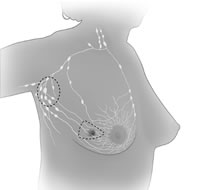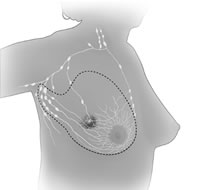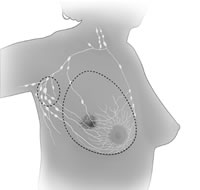 Breast-conserving surgery. Dotted lines show the area containing the tumor that is removed and some of the lymph nodes that may be removed. In total (simple) mastectomy, the surgeon removes the whole breast and some lymph nodes under the arm.
Breast-conserving surgery. Dotted lines show the area containing the tumor that is removed and some of the lymph nodes that may be removed. In total (simple) mastectomy, the surgeon removes the whole breast and some lymph nodes under the arm.  Modified radical mastectomy. The dotted line shows where the entire breast and some lymph nodes are removed. Part of the chest wall muscle may also be removed.
Modified radical mastectomy. The dotted line shows where the entire breast and some lymph nodes are removed. Part of the chest wall muscle may also be removed.
 Total (simple) mastectomy. The dotted line shows where the entire breast is removed. Some lymph nodes under the arm may also be removed.
Total (simple) mastectomy. The dotted line shows where the entire breast is removed. Some lymph nodes under the arm may also be removed.Your Marshfield Clinic Cancer Specialist has many surgical options that range from breast-sparing surgery to complete removal of the breast and surrounding tissue.
Your alternatives will be determined by where to cancer is located, its stage and your general health.
Breast-Sparing Surgery
This type of surgery removes the cancer, but retains most of the breast and breast tissue. Also known as breast-conserving surgery, a biopsy of the lymph nodes under the arm is often a part of this surgery.
The laboratory checks the lymph node samples for the presence of cancer cells. If the biopsy reveals cancer, your doctor may suggest additional treatments.
You may have a lumpectomy or a segmental mastectomy depending on the stage of the cancer.
A lumpectomy involves removing the cancer from your breast, but leaving most of the breast tissue intact.
A segmental mastectomy (also known as a partial mastectomy) removes the cancer as well as some of the breast tissue. The surgery also removes tissue from the lining over chest muscles under the tumor.
Mastectomy
A mastectomy removes the entire breast. The surgeon may try to spare as much skin as possible to aid in reconstructive surgery.
A total or simple mastectomy removes the whole breast and often some of the lymph nodes under the arm.
In a modified radical mastectomy, your surgeon removes the whole breast and the lymph nodes under the arm. The lining over your chest muscles is also remove and, possibly, a muscle that allows easier surgical access to lymph nodes.
Additional Surgery
If the breast cancer has spread to other parts of the body, your doctor may recommend additional surgery.
Recovery from Surgery
Healing time from surgery will depend on several factors. The extent of the surgery, your general health and age may shorten or lengthen your recovery.
You should discuss pain management with your doctor before surgery. While you are healing, you may experience discomfort and tenderness.
Your doctor will discuss other complications or conditions that may arise during your recovery and may have you work with other health care professionals such as a physical therapist.
One common complication following removal of lymph nodes under the arm is lymphedema. This condition arises when fluid builds up in your arm and hand and causes swelling. You should protect the arm and hand from cuts or other injuries.
If left untreated, the accumulation of protein-rich lymph fluid creates an ideal environment for bacteria to grow and increases the risk for infection. Lymphedema can also cause pain, heaviness, and hardened tissue with restricted motion and use in the affected limb.
